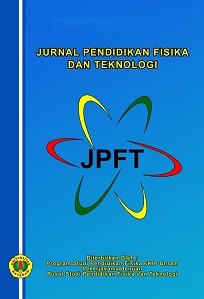Development Teaching Basic Skillââ¬â¢s VCD Media to Improve Teaching Skills in Subjects Micro Teaching
DOI:
10.29303/jpft.v4i2.837Published:
2018-11-22Issue:
Vol. 4 No. 2 (2018): Juli-Desember 2018Keywords:
Media, VCD, Basic Teaching Skills, Micro TeachingArticles
Downloads
How to Cite
Downloads
Metrics
Abstract
This study aims to: 1) determine the quality of the results of VCDs that have been developed, 2) find out whether there is an increase in student teaching skills in micro-learning. This research is a development research using ADDIE (Analysis, Design, Development, Implementation and Evaluation) models. Validation of learning videos is done by learning media experts and user response questionnaires. Data analysis used descriptive analysis and N-Gain test. The results showed that the average score of the media expert validation was 86.7% in the good and usable category, while the results of the user response questionnaire were 87.9% in the good category and suitable for use. Hail the N-gain test found that there was an increase in the basic teaching skills of students after using the VCD of basic teaching skills in the micro-learning course which was 0.7.References
Arsyad A. 2011. Learning media. Jakarta: Grafindo Persada.
Daru W. 2011. Development of Physics Learning Media for Video Formats for Increasing Competence of Middle School Students. Proceeding for National, Surakarta: Eleven Teaching and Education Faculties March Surakarta.
Gunawan. 2015. Science Learning ICT Based Model. Mataram: FKIP
University of Mataram.
Hamdanilah, N., Harjono, A., Susilawati. 2017. Effect of Advanced Organizer Learning Models with Learning Videos on Physics Learning Outcomes of Class XI MIA Students of SMAN 2 Labuapi. Jurnal Pendidikan Fisika dan Teknologi. 3(2), 119-127.
Herayanti, L., Fuaddunnazmi, M., Habibi. 2015. Moodle-based Media Development in Basic Physics Courses. Jurnal Pendidikan Fisika dan Teknologi. 1(3), 205-209.
Purwono, J. Yutmini, S. Anitah, S. 2014. Use of Audio Visual Media in Natural Sciences Subjects in SMP Negeri 1 Pacitan. Jurnal Teknologi Pendidikan dan Pembelajaran. 2(2), 127-144.
Hasan, H. 2016. Usage Audio Visual Media for Mastery of Social Studies Learning Material for Development of Production, Communication and Transportation Technology in Class IV Students of SD Negeri 20 Banda Aceh. Basic Charm Journal. 3(4), 22-33.
Hake, RR 1999. Analyzing Change / Gain Scores. Department of Physics, Indiana University.
Rahayu, S., Mertha, IG 2017. Micro Teaching. West Lombok: Arga Puji Press.
Rahayu, S., Mertha, IG 2017. Development of Teaching Materials for Micro Teaching to Train Pedagogical Competencies for Prospective Teachers. Jurnal Pendidikan Fisika dan Teknologi. 3(2), 232-238.
Tegeh, IM, Kirna, IM Development of Teaching Materials for Educational Research Methods with the ADDIE Model. IKA Journal. 11 (1), 12-26.
Singh, YK & Sharma, MSA 2004. Micro Teaching. New Delhi: APH Publishing Corporation.
Author Biography
Satutik Rahayu, Universitas Mataram
License
Authors who publish with Jurnal Pendidikan Fisika dan Teknologi (JPFT) agree to the following terms:
- Authors retain copyright and grant the journal right of first publication with the work simultaneously licensed under a Creative Commons Attribution License 4.0 International License (CC-BY-SA License). This license allows authors to use all articles, data sets, graphics, and appendices in data mining applications, search engines, web sites, blogs, and other platforms by providing an appropriate reference. The journal allows the author(s) to hold the copyright without restrictions and will retain publishing rights without restrictions.
- Authors are able to enter into separate, additional contractual arrangements for the non-exclusive distribution of the journal's published version of the work (e.g., post it to an institutional repository or publish it in a book), with an acknowledgement of its initial publication in Jurnal Pendidikan Fisika dan Teknologi (JPFT).
- Authors are permitted and encouraged to post their work online (e.g., in institutional repositories or on their website) prior to and during the submission process, as it can lead to productive exchanges, as well as earlier and greater citation of published work (See The Effect of Open Access).











